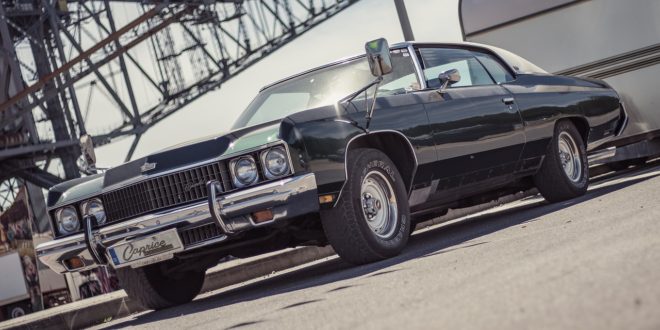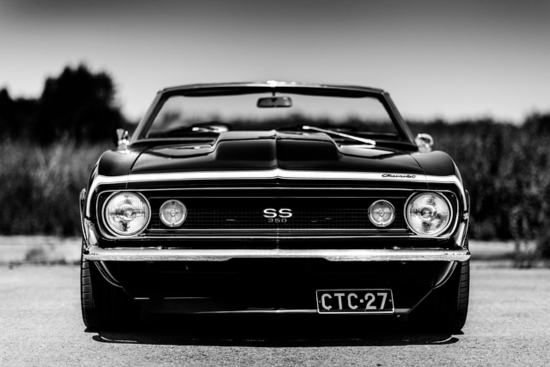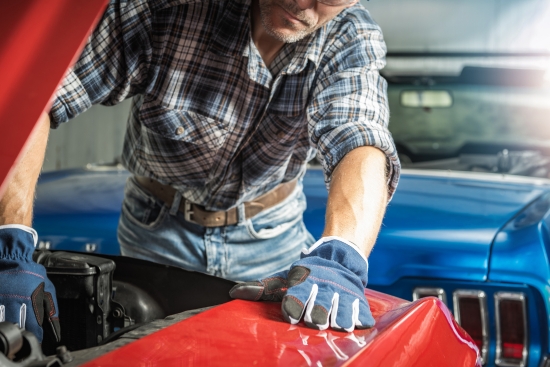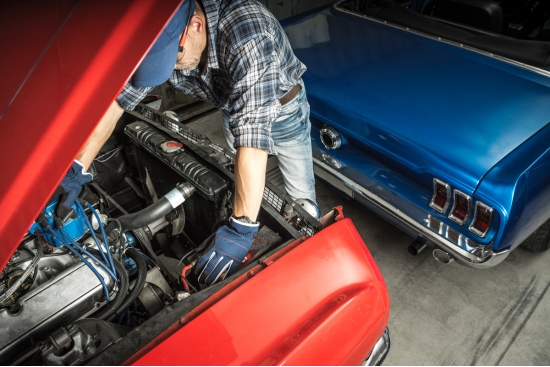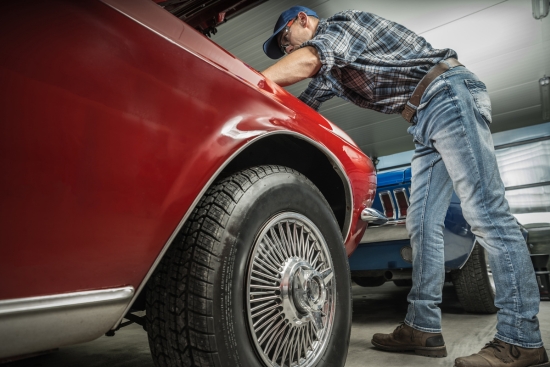Restoring a muscle car takes about 1000 hours worth of work on average. That is assuming you have some experience, the tools, and the skills to take it all the way from start to finish. Any restoration project also requires money and space, plus with a muscle car you need to know where to find vintage parts. Sometimes it makes sense to get help on your restoration process. Below I will share where to find restoration help, how to evaluate them, and how to take full advantage of their services. I will also share my experience with the muscle car restoration near me.
Find Muscle Car Restoration Near Me…
If you searching for “Muscle Car Restoration Near Me”, see the map below…
If you have an old beat-up American rear-wheel drive monster with a large displacement V8 engine, you have to be thinking about restoring it. Muscle car restoration projects are a lot of fun but require time, skill, space, tools, and some money. Sometimes we take on these projects and get in over our heads and need some help or we don’t have the tools to do it. This is how I found the muscle car restoration near me, just needed one thing done and now I outsource several tasks to them.
How the Muscle Car Restoration Near Me Works
A muscle car restoration shop isn’t your local auto body shop. These are shops that can do a complete teardown of your vehicle for a full restoration. Some shops specialize in only muscle cars while others will do hot rod modifications or only original classic cars.
A muscle car restoration shop is stocked with mechanics who have in-depth knowledge of American manufacturing. They also will specialize in a range of specific automotive disciplines. For example, you will have an engine guy, a paint guy, a fabrication guy, a rust guy, etc…
For some of these businesses, you can drop off a vehicle straight from the junkyard and then pick it up when it’s done. Of course, what is the fun in that, and having that done costs a lot of money?
What I like to do is use these resto shops for very specific tasks. For example, if I was looking to rebuild an old 389 cu in (6.4 L) V8 for a 64 Pontiac, I would consider having a specialist do the rebuild. For me replacing the engine is one thing, but rebuilding it is another. While I work on finding other parts and restoring the rest I outsource the task, which improves the reliability of my build and helps me reduce my time to completion.
Why Get Help On Your Antique Muscle Car Restoration Project?…
I used to think doing a muscle car restoration was a one-man job. I took pride in doing all the work. However, after wasting a lot of time and money and seeing areas where my work isn’t top-notch, I started outsourcing. Some tasks I outsource because I hate doing them, like rust work, but other tasks are about getting expert help.
Sometimes it just makes sense to pay a professional. It may be a matter of not having the tools or skills and that’s ok. All you should care about in the end is how the car looks and performs.
Here are some tasks a restoration shop can help with:
- Frame repairs (The structural integrity is critical)
- Rust removal
- Finding Instrument & Gauge Clusters
- Powertrain mods and upgrades
- Suspension mods and upgrades
- Paintwork (especially if you envision custom paint)
- Any frame off services
- Electrical work and diagnostics
- Performance upgrades and custom tuning
- Interior upgrades and adding in newer technology
Every project starts with passion and a feeling you can do it all yourself. Eventually, you learn you can waste more time and money by doing your own work.
Word of Advice Before You Start…
If you have not even bought your project car yet, it’s called to call your local auto resto shop first. Find out what they do, how busy they are, and their process. Some may specialize in bodywork, while others may specialize in upholstery. Share with them your plan, budget, and if you have pics of the vehicle share them.
In my experience with the muscle car restoration near me, they will help you set realistic expectations. They deal with this every day and can tell you what the issues are that will arise.
Also, you should try and find the original car manual for your vehicle. Here are our 8 best places to find old car manuals.
When You Call a Shop Be Specific About The Type of Restoration
Are you a purist or are you looking to build a muscle car that meets your personal style or even a classic resto mod?
Whenever you outsource a classic car to a restoration shop, you need to be clear about what you want. If you want your 1970 Plymouth GTX 440 to have a new radio and USB ports, that is fine, just be clear. Imagine that you wanted that same car all original and they modified it.
Make sure that you guys are on the same page for whatever work they are doing. I’ve seen shops add a scoop to an original hood when the owner didn’t want that done. Just was a matter of miscommunication, but none the less not cool.
Pain Points You May Want to Outsource…
Restoring your own American classic is fun. So understand that I am not suggesting completely letting someone else do your resto. Here are some tasks though to consider getting assistance if needed…
Paint and Body Work
Certain bodywork is easy to do yourself. If it’s just a matter of banging dings and dents out of a panel, no big deal. When you start getting to rust and panel fabrication, it gets more complicated. Hopefully, you’ve chosen a project with little rust work, but sometimes it’s unavoidable. These are tasks you can consider outsourcing. You can drop off parts like a bumper for a chrome restoration or a hood to be refitted to fit.
Paint work is also a nice piece to outsource. This is particularly true for custom work like pinstripes, flames, or anything special. What I like about a good restoration shop is they not only have the specialists, but they know the exact color numbers to restore a car to its production line debut.
Finding Original Parts
When a car sits for a long time parts corrode and eventually seize. This means you are going to need to find replacement parts. Junkyard digging and online searches can get you pretty far. Sometimes though you come across a piece that you just can’t find or you find it and the condition is too far gone.
This is where having a relationship with a restoration shop is helpful. They know the junkyards, forums, and catalogs to check. Even more so they have an extensive network of other restoration people to leverage. For a fee, you can have them source hard-to-find original parts for you.
Mechanical Work
Finding and replacing a muscle car engine or transmission is pretty common and can be done on your own. Engine and transmission replacement, while less expensive though is often looked at as a temporary solution. Ideally, you want a rebuild.
A rebuild is a full disassembly where every part is inspected, cleaned, and if needed replaced. Doing this on your own is risky as you can do more damage to the parts. For anything like an engine or transmission rebuild, I would suggest finding a shop to do it. Plus you will get a warranty on the work.
Electric and Wiring Work
When a car sits the wiring takes on moisture. Depending on where it was stored may have had mice chew through wires. Redoing the wiring is on the lighter side of restoration, but without automotive electrical experience, you may want to outsource the work.
A muscle car restoration will not only know the original wiring patterns but also know the voltage requirements and get everything appropriately labeled and hidden.
Interior Work
Basic interior work you can get help with is upholstery, dashboard work, carpeting, headlining etc. While I find those tasks doable, what is good to look for help with is signs of larger issues like wet floorboards or mold. Identifying where the water or moisture is coming from and stopping it correctly. Not identifying or dealing with big issues like that will lead to destroying your hard work later.
Choosing the Best Muscle Car Restoration Shop
You can find resto shops that do a complete start-to-finish job or one of restoration work. I tend to like specialty shops, you get a better price, and you are getting the one service that they are known for. For example, I like getting my paint done, specifically by a guy who that’s all he does. I find that keeps my budget in order and when I hire out for work, I get the highest quality I can afford.
When selecting a muscle car restoration near me here is what I look to do:
- Call around to different places, get quotes, and talk shop.
- Get before and after pictures of their past projects.
- Read reviews and testimonials on Yelp and Google.
- Get them to estimate how long the work will take.
- Ask about what guarantees and assurances do I have.
- Ask them for advice on my project and pick their brain.
If you are getting work done and intend to sell it to a person who buys classic cars, make sure you weigh the costs into the total value of selling the vehicle. You want to leave room for a profit if you are flipping the vehicle.
Maintaining Your Restored Muscle Car
Regular Maintenance Tips
Maintaining a restored muscle car is crucial to keep it running smoothly and looking its best. Regular maintenance involves a few key steps that ensure your classic car remains in top condition.
Firstly, it’s essential to regularly check and change the oil. Muscle cars, especially those with high-performance engines, need clean and adequate oil for optimal functioning. Also, keep an eye on the coolant levels to prevent overheating, a common issue with older car models.
Secondly, the brake system of your classic muscle car requires regular inspections. Replace brake pads and fluids as needed to ensure your car stops effectively and safely.
The electrical system in classic cars can be tricky, so it’s important to check the battery and wiring regularly. Older cars might have outdated wiring, which can lead to electrical problems if not maintained properly.
Preservation Techniques
Preserving a muscle car goes beyond regular maintenance. It involves protecting the car from elements that can degrade its condition over time.
One key aspect of preservation is storing your car in a dry, temperature-controlled environment. This protects it from rust and paint damage. If you live in an area like Chippewa Falls, where the climate can vary, proper storage is even more crucial.
Using a quality car cover is also essential, especially if you don’t have access to indoor storage. A cover protects the paint and body from dust, moisture, and sunlight, all of which can harm the car’s exterior.
Regular detailing is another important preservation technique. This includes thorough cleaning, waxing, and polishing of your car. Not only does this keep your car looking great, but it also protects the paint and bodywork.
Lastly, drive your muscle car regularly. This might seem counterintuitive, but cars are meant to be driven. Regular use helps keep the mechanical parts in good working order and can actually prevent issues that arise from letting a car sit idle for too long.
In conclusion, maintaining and preserving a restored muscle car requires commitment and passion. By following these tips, you ensure that your classic vehicle continues to bring pleasure and pride for years to come, retaining its former glory and value as a cherished piece of automotive history.
The Future of Muscle Car Restoration
Trends and Innovations
The world of muscle car restorations is evolving rapidly, with new trends and innovations shaping its future. Enthusiasts of classic muscle cars are witnessing a blend of traditional restoration techniques with modern technology. This fusion not only enhances the quality of restorations but also makes them more accessible and affordable.
One significant trend is the increasing use of digital tools in the restoration process. Advanced software is now used for detailing every aspect of a classic car, from the frame to the painting. This precision ensures that every muscle car restoration maintains its former glory while incorporating modern safety and performance enhancements.
The Role of Technology in Restoration
Technology plays a pivotal role in the future of muscle car restorations. 3D printing, for instance, is revolutionizing the way parts are reproduced, especially for rare models where original parts are hard to find. This technology allows restorers to create exact replicas, ensuring that even the most unique muscle cars can be restored to their original condition.
Moreover, the integration of electric powertrains in classic cars is a growing trend. This not only addresses environmental concerns but also opens up new possibilities in performance. Muscle car enthusiasts can now enjoy the classic look with a modern, eco-friendly twist.
In conclusion, the future of muscle car restorations is exciting and promising. With the blend of traditional craftsmanship and cutting-edge technology, these timeless vehicles will continue to capture the passion and dreams of collectors and enthusiasts alike. The muscle car legacy is set to thrive, adapting and evolving with the times while preserving its iconic status in automotive history.
Muscle Car Restoration Near Me – Conclusion
On any restoration project, you are bound to run into some issues. Nothing ever goes as planned and when you need help you should ask for it. Sure getting some restoration help costs money, but it also cuts the completion time down by having a pro do the work.
Just because you send a few panels out for rust help doesn’t make this any less relevant to your restoration. That is just working smarter and not harder. That is what I have learned by leveraging the muscle car restoration near me.

